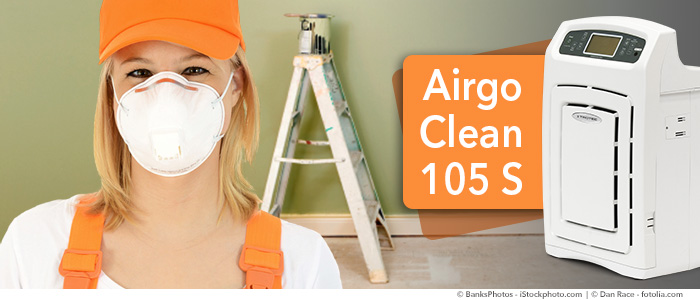During renovation works materials can be released which cause allergy-related health problems or which worsen other hypersensitivities. As some substances don’t just trigger allergic reactions, but are in fact also damaging to health, all handymen and professional craftsmen should protect themselves during renovation works, not just those who suffer from allergies. Here we’ve complied a whole range of tips to help with this…
Tip 1: Necessary preparatory work
Often only one room needs renovating while the other rooms remain occupied. Make sure no dust gets into these other rooms: simply hang damp sheets in the doorways or tape plastic sheeting over the entrance and leave just a small gap to walk through. Seal off the space under doors using blankets and stretch another plastic sheet across the bedroom door to prevent the substances released from getting into the bedroom. Using a professional air purifier such as the AirgoClean 105 S has also proved helpful. The advantage: it ensures the air is clean and healthy even after the renovation works have finished.
Important: renovation works on buildings contaminated with mould or asbestos involve particular health risks even including an incalculable risk of cancer. For this reason, any work to remove mould or asbestos should be left to specialist companies.
Tip 2: Removing old wallpaper
Removing old wallpaper and floor coverings is particularly problematic for allergy sufferers as it causes harmful substances to get into the air and in contact with skin. For this reason, wallpaper should be soaked thoroughly with water before it is removed so that it can be taken off the walls more easily and so that less dust gets into the air. Because mould spores in wallpaper cannot be seen with the naked eye, it is strongly advisable, particularly for people with allergies, to wear breathing filters (particle filters) which protect against these substances when carrying out such works. People with contact allergies should also ideally wear a protective suit to stop dust settling on the skin.
Tip 3: Removing old paints
We recommend wearing a breathing filter even when removing emulsion paint which is actually considered harmless. This is because substances such as isothiazolinones, which should also not be inhaled, are often added to them as a preservative.
If you would like to remove paint by sanding down furniture, you should ideally do this outside. You can remove paint from wood indoors using a scraping tool such as a knife without too much dust pollution being released into the air. Nonetheless, you should still wear a protective breathing mask. If you want to use paint stripper to remove paint from wood, you should also wear protective glasses, clothing and gloves as the paint stripper solution can burn the eyes and skin.
Tip 4: Removing old floor coverings
When removing old floor coverings you should also put on protective clothing and breathing masks if possible. Vacuum clean carpets and wet them before taking them out to avoid dust getting into the air. Allergy sufferers should also always remember to remove glue residues from floors. Wallpaper and residues from paints, glues and carpets that have been removed are best taken out of the room straight away, otherwise they will continue to release their allergenic substances into the air. If you sand down floor coverings, always use a sanding machine with a dust collection bag.
Tip 5: The right choice of new paint, wallpaper and flooring
When choosing new paints, wallpapers and floor coverings allergy sufferers should pay particular attention to materials that are not hazardous to health. They shouldn’t contain any solvents or resins. However sometimes even mostly natural or ecologically safe paints and other materials sometimes contain other substances which can trigger or worsen allergies. Products with the “blue angel” eco label are generally much better for your health. Alternatively you can rely on the TÜV stamp “suitable for allergy sufferers” when choosing paints and wallpapers.
Wood-chip or plain wallpapers are more suitable for allergy sufferers than those that contain plastics or preservatives. After putting up wallpaper or painting walls you should heat the room well so that the wallpaper and paint can dry out thoroughly. After this you should let the room air fully so that all of the chemicals and odours can escape.
Those who suffer from allergies should also think carefully about selecting a suitable floor covering. For those allergic to house dust, smooth, wipeable floors are only recommendable if they can be wiped wet every two days. Allergy sufferers who prefer carpets should make sure they have not been treated with moth repellents or other harmful substances before they buy them.
Tip 6: The right choice of new furniture
When buying new furniture, make sure the chipboard panels do not contain any substances that are harmful to health such as formaldehyde. You can easily detect formaldehyde by its pungent odour. It is best to steer well clear of such purchases because this substance doesn’t just irritate the airways, it is also carcinogenic.
Tip 7: The AirgoClean 105 S air purifier – your professional partner in renovation work
Anyone who wants to renovate their home themselves in spite of their allergies would do well to trust in a professional air purifier like the AirgoClean 105 S. This is because the AirgoClean 105 S frees the air in work spaces, living rooms and bedrooms of the harmful mix of renovation dust, house dust, pollen, allergens and animal hair efficiently and fully automatically.
Find out about all of the ways our air purifier could benefit you and make the most of our current offer: order the AirgoClean 105 S for just £ 138.78 instead of £ 275.33 incl. VAT – in the Trotec shop now!


